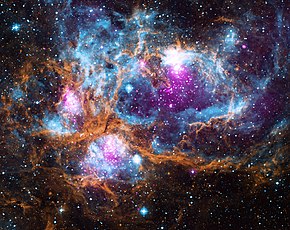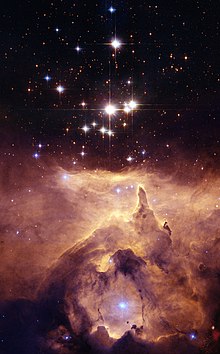| Emission nebula | |
|---|---|
| H II region | |
 NGC 6357 composite image | |
| Observation data: J2000 epoch | |
| Right ascension | 17h 24m [1] |
| Declination | −34° 20′ [1] |
| Distance | ~5900±450 [2] ly (1800±140 pc) |
| Constellation | Scorpius [3] |
| Designations | War and Peace Nebula, [1] Lobster Nebula [4] Sharpless 11, RCW 131, Gum 66, Madokami |
NGC 6357 is a diffuse nebula near NGC 6334 in the constellation Scorpius. The nebula contains many proto-stars shielded by dark discs of gas, and young stars wrapped in expanding "cocoons" or expanding gases surrounding these small stars. It is also known as the Lobster Nebula. [4] [5] This nebula was given the name War and Peace Nebula by the Midcourse Space Experiment scientists because of its appearance, which, in infrared images the bright, western part resembles a dove, while the eastern part looks like a skull. [6] A petition by anime fans to rename it as the Madokami nebula, due to resemblance with a character, was unsuccessful. [7] [8]
Contents
- Associated open clusters
- Pismis 24
- G353.2+0.7
- G353.1+0.6
- Massive stars
- See also
- References
- External links
It is located about 5,500 light years away from Earth. [9] NGC 6357 is connected by a filamentary structure to NGC 6334, and the two may form a single complex. [10]

